Japanese text-to-speech (TTS) technology has significantly improved, providing realistic AI-generated voices for multiple applications. Whether you're a language learner, content creator, or business professional, having access to a high-quality Japanese text reader can enhance pronunciation, accessibility, and voiceover production. This guide will explore how Japanese text-to-speech works, introduce the best AI-powered tools, and highlight common use cases to help you find the perfect TTS software for your needs.
In this article
Part 1: How Does Japanese Text to Speech Works?
Japanese text-to-speech (TTS) technology is an AI-driven system that converts written Japanese text into natural-sounding speech. It uses advanced neural networks to ensure proper pronunciation, tone, and fluency. Some tools also offer Japanese accent text-to-speech, making the speech more expressive and lifelike.
Key Features of Japanese TTS Systems:
- Neural AI Voices – Generates lifelike, human-like speech with accurate intonation.
- Customizable Speech Settings – Users can adjust speed, pitch, and tone for a natural flow.
- Multiple Dialects & Accents – Some tools provide Tokyo, Kansai, or other regional accents.
- File Export Options – Convert Japanese text to voice and download as MP3 or WAV.
- Offline & Cloud-Based Services – Some software works offline, while others require an internet connection.
How AI Improves Japanese Text-to-Voice Quality
AI-powered Japanese text-to-voice systems continuously learn from native speech patterns to improve intonation and fluency. Modern deep-learning models ensure accurate pronunciation, making these tools ideal for learning and content creation.
Part 2: The Perfect Solution for Converting Japanese Text to Speech
UniConverter – The Best AI-Powered Japanese Text-to-Speech Tool
UniConverter is an AI-powered Japanese text-to-speech (TTS) solution that provides highly realistic voice synthesis. Whether you're using it for e-learning, content creation, or business applications, UniConverter offers accurate pronunciation and customization options for a natural listening experience. The tool supports both male and female Japanese AI voices, allowing users to choose the ideal tone for their projects. It also features adjustable speech rate and pitch, making it perfect for narrations, audiobooks, and Japanese language learning. With batch processing support, UniConverter can efficiently convert multiple Japanese text files into speech at once, saving time for professionals. Additionally, the software enables MP3 and WAV exports, ensuring compatibility across video editing software, presentations, and multimedia applications.
Best Text to Speech Converter
Key Features:
- Neural AI Voice Generation – Produces lifelike Japanese text-to-speech with accurate pronunciation.
- Multiple Voice Styles – Offers different male and female AI voices for professional use.
- Adjustable Speech Rate & Pitch – Customize speed and tone for more expressive speech.
- Batch Processing for Multiple Texts – Convert multiple Japanese text files at once.
- MP3 & WAV Export – Save Japanese text-to-speech audio for videos, presentations, and e-learning.
Steps to Convert Japanese Text to Speech Using UniConverter
Step 1: Upload or Enter the Japanese Text
Launch UniConverter, navigate to the Text-to-Speech section, and enter your Japanese text manually or upload a document. The tool supports multiple text formats, ensuring smooth and efficient conversion.

Step 2: Select a Japanese AI Voice and Adjust Settings
In the text input box, type or paste the Japanese text you want to convert into speech. Next, browse through the Voice Library to select a suitable Japanese AI voice. You can use the filter option to refine your search based on different voice styles, such as Narration, Advertisement, or Conversational tone. Once selected, ensure the preview is set to Japanese before clicking the "Generate" button to proceed.
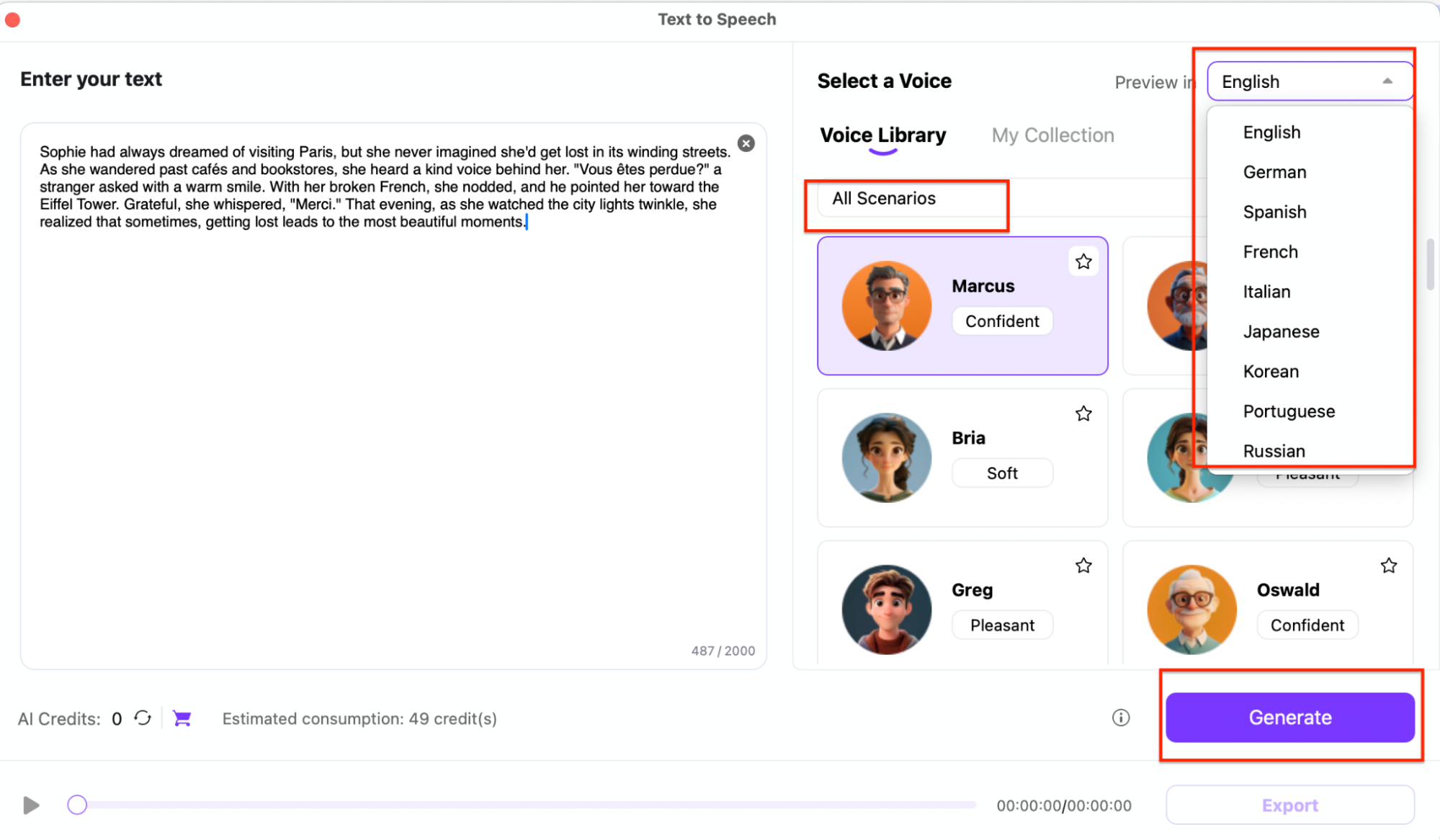
Step 3: Preview and Export the Audio File
After generating the Japanese text-to-speech output, preview the audio by clicking the play button at the bottom left of the screen. This allows you to check the pronunciation, tone, and speed of the AI voice. If needed, go back to adjust the text or select a different voice. Once satisfied, click the "Export" button to download the speech file in MP3 format, making it ready for use in presentations, videos, or e-learning projects.
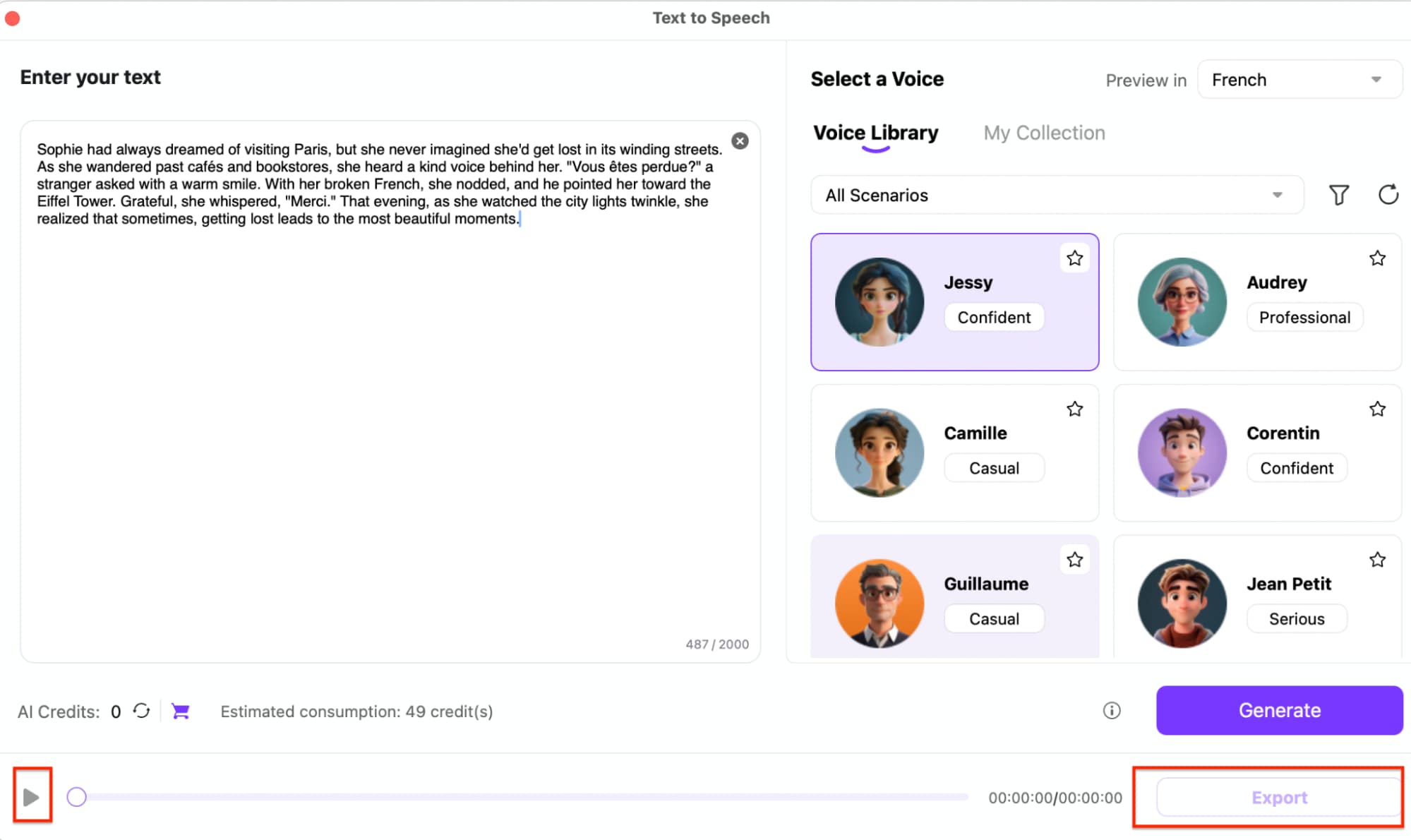
Part 3: Other 5 Japanese Text-to-Speech Tools You Can Rely On
Apart from UniConverter, there are several other Japanese text-to-speech (TTS) tools that provide realistic AI-generated voices for learning, business, and content creation. Below are five high-quality Japanese text-to-voice generators, each offering unique features for pronunciation enhancement, accessibility, and multimedia production.
1. Narakeet
Narakeet is a video and presentation voiceover tool that supports natural-sounding Japanese AI voices. It is designed for educators, business professionals, and content creators who need quick and professional voice narration. With automatic text-to-speech conversion, it allows users to create Japanese voiceovers for slideshows, videos, and tutorials. Narakeet’s AI voices sound clear and expressive, making it an excellent alternative to hiring voice actors. Users can also adjust pronunciation, tone, and speed for a more personalized speech output.
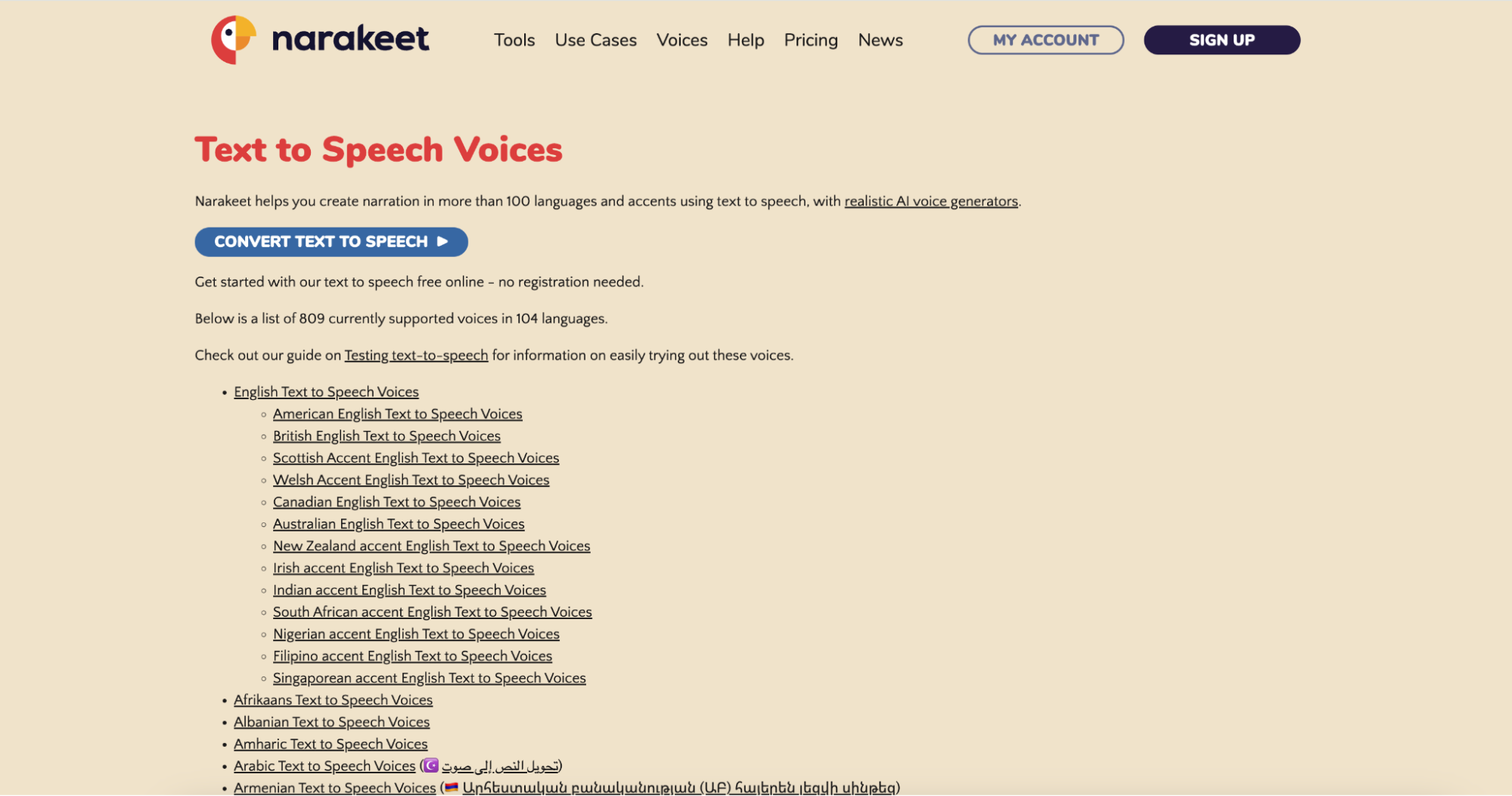
Key Features:
- Multiple AI Japanese Voices – Offers male and female voice options with natural pronunciation.
- Seamless Video Narration – Integrates with slideshows and presentations to create voiceovers instantly.
- Custom Speech Controls – Users can adjust speed, pitch, and tone for better vocal clarity.
- Supports SSML Markup – Enhances speech synthesis with pauses, emphasis, and expressions.
- MP3 & MP4 Export – Allows users to download audio separately or merge it with videos.
Steps to Use Narakeet:
Step 1: Upload or Paste Text
Visit Narakeet's website, upload your Japanese text file, or manually paste the text into the editor.
Step 2: Select a Voice & Customize Speech
Choose a Japanese AI voice, adjust speech speed, pitch, and tone, and apply custom SSML tags for better pronunciation.
Step 3: Generate & Export the Voice File
Click Convert, preview the audio, and download the final speech output as an MP3 or MP4 file.
2. Ondoku
Ondoku is a web-based Japanese text-to-voice tool that delivers high-quality AI-generated speech. It is popular among students, audiobook creators, and educators due to its clear pronunciation and ease of use. The platform allows customization of speech speed, pitch, and voice style, making it versatile for different applications. Ondoku also supports MP3 and WAV downloads, allowing users to save their text-to-speech conversions for offline use. Since it is browser-based, no software installation is required, making it easily accessible on PC, Mac, and mobile devices.
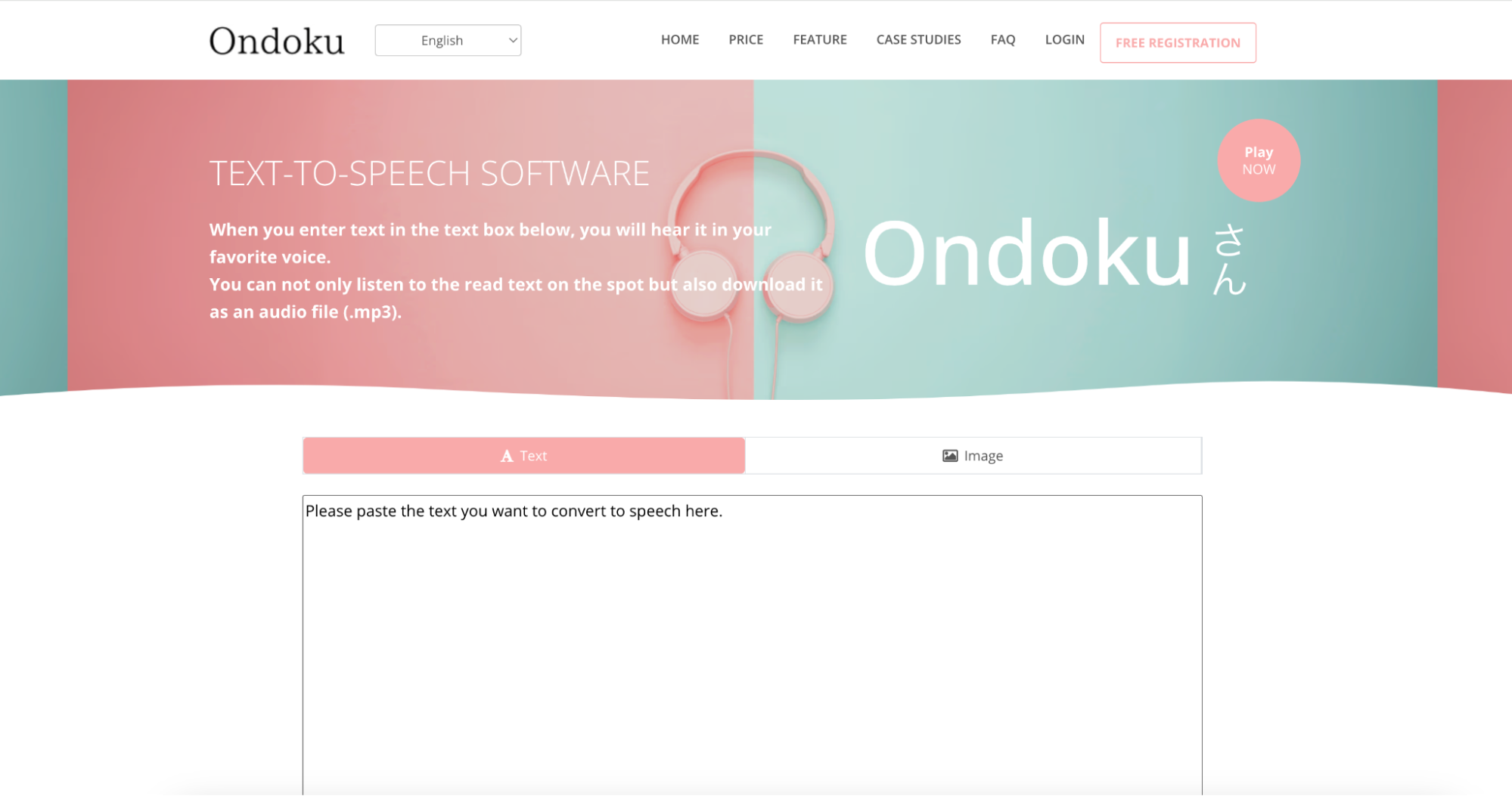
Key Features:
- Natural Japanese Speech Output – Uses AI neural networks for lifelike speech synthesis.
- Adjustable Speed & Pitch – Users can modify vocal tone, pitch, and rate for better clarity.
- Web-Based & No Installation Required – Works entirely online, making it accessible from any device.
- MP3 & WAV Export Options – Saves text-to-speech audio files for later use.
- Supports Large Text Files – Handles long-form text for audiobook and e-learning applications.
Steps to Use Ondoku:
Step 1: Open Ondoku Online
Go to the Ondoku website and enter your Japanese text in the provided input field.
Step 2: Choose a Japanese Voice & Adjust Settings
Select a male or female Japanese AI voice, adjust speed, pitch, and volume for a natural speech output.
Step 3: Convert & Download the Speech File
Click Generate Speech, preview the result, and download the final audio file in MP3 or WAV format.
3. CoeFont
CoeFont is a cutting-edge Japanese AI text-to-speech platform that specializes in realistic, expressive voice synthesis. It is widely used for podcasts, business presentations, and digital assistants due to its human-like speech quality. CoeFont allows users to adjust intonation, expressiveness, and rhythm, making the speech output sound more engaging and natural. With a cloud-based interface, users can easily generate voiceovers without downloading software. This tool is ideal for professionals looking to create custom AI-generated Japanese voices for their projects.
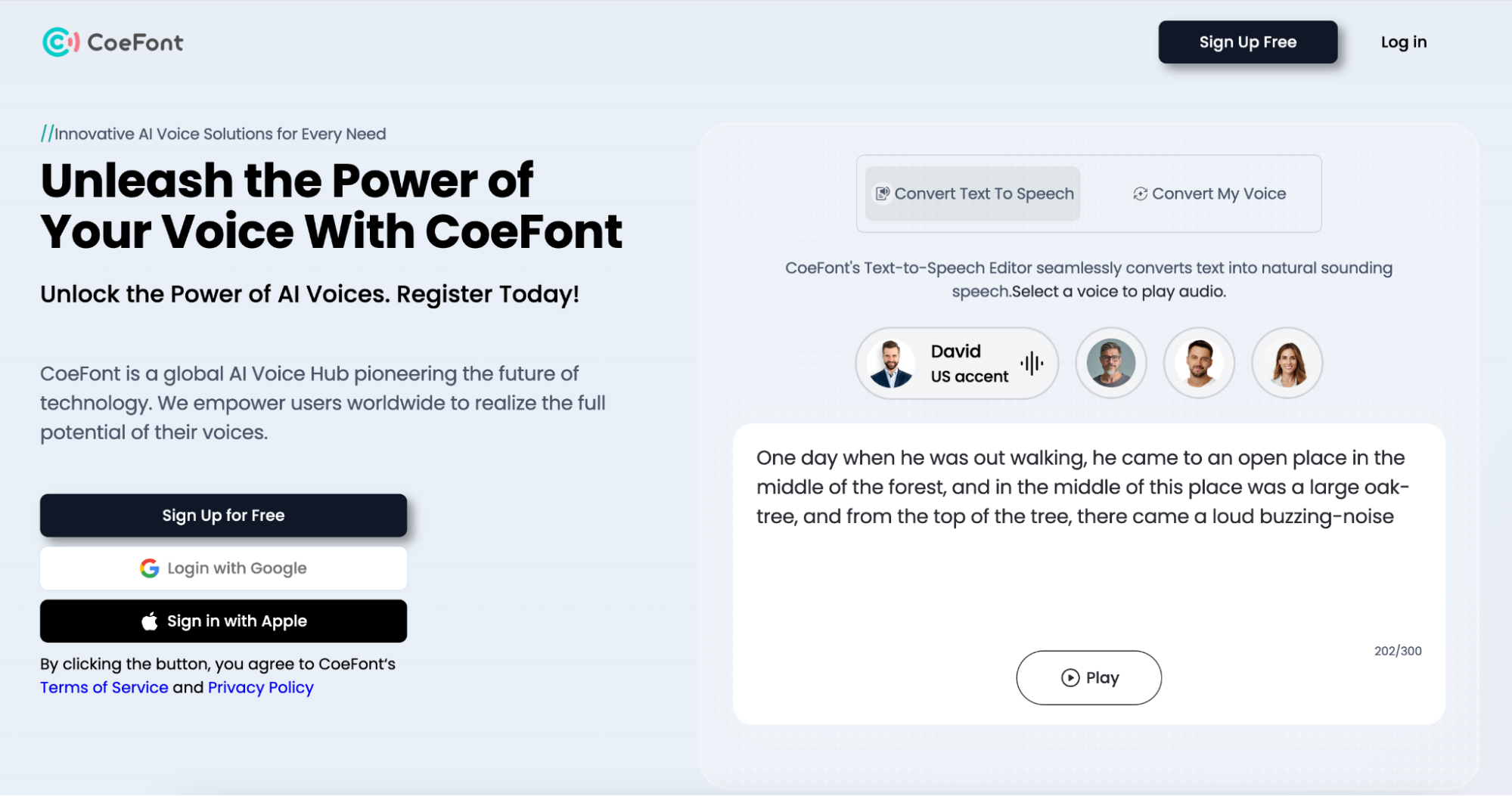
Key Features:
- High-Quality Japanese Neural Voices – Uses AI-driven speech synthesis for ultra-realistic audio.
- Customizable Tone & Emotion – Adjusts intonation, excitement, and pitch to match the content.
- Online-Based Voice Editing – Allows real-time speech modification through a cloud-based platform.
- Supports Professional Voiceovers – Ideal for corporate, commercial, and e-learning content.
- File Export in Various Formats – Downloads MP3 and WAV files for versatile applications.
Steps to Use CoeFont:
Step 1: Sign in & Enter Your Japanese Text
Visit CoeFont's official platform, create an account, and paste or upload your Japanese text.
Step 2: Select a Voice & Adjust Expression
Pick a Japanese AI voice, modify speech settings, and experiment with different vocal expressions.
Step 3: Convert & Download the Final Speech Output
Click Generate, review the voice output, and export it as an MP3 file for further use.
4. VOXify
VOXify is an advanced Japanese text-to-speech (TTS) tool that provides high-quality AI-generated voices for various applications. Designed for content creators, educators, and businesses, VOXify delivers realistic Japanese AI voices with customizable options for pitch, speed, and tone. It supports multiple accents and speaking styles, making it a versatile tool for narration, audiobooks, voiceovers, and automated assistants. With cloud-based AI processing, users can access VOXify online without downloading any software, ensuring effortless and professional speech synthesis.
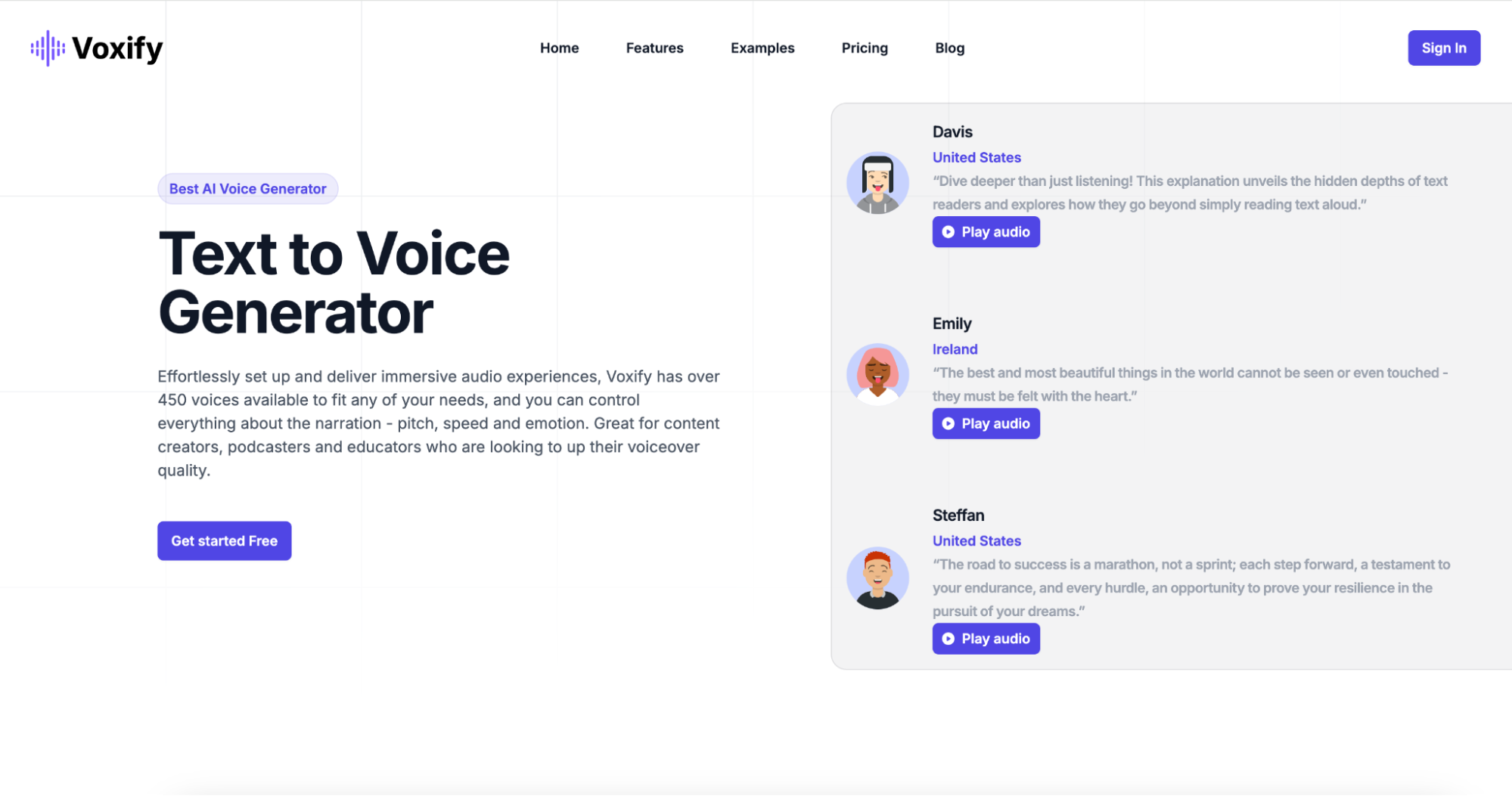
Key Features:
- Free & Open-Source TTS Software – Provides accessible Japanese text-to-speech tools for all users.
- Emotion-Based Speech Output – Adjusts tone, excitement, and speech style for anime and narration.
- Supports Multiple Japanese Voice Models – Offers various voice characters with natural accents.
- High-Quality AI Voice Processing – Generates clear and fluent speech with low latency.
- Ideal for Content Creators – Used in YouTube, anime, and indie game projects.
Steps to Use VOXify:
Step 1: Open VOXify & Enter Your Japanese Text
Go to VOXify’s website and navigate to the Text-to-Speech section. Enter or paste the Japanese text you want to convert into speech. The tool supports Kanji, Hiragana, and Katakana, ensuring accurate processing.
Step 2: Select a Japanese Voice & Adjust Settings
Choose from various AI-generated Japanese voices, including male, female, and different speaking tones. Adjust speed, pitch, and intonation to match your specific needs for narration, voiceovers, or learning purposes.
Step 3: Generate & Download the AI Speech File
Click "Generate" to process the Japanese text into speech. Once the AI has converted your text, preview the output and download the final speech file in MP3 or WAV format for use in videos, presentations, or learning materials.
5. ReadSpeaker
ReadSpeaker is a premium AI-powered text-to-speech tool that specializes in high-quality Japanese voice synthesis. It is designed for business, accessibility, and education, offering natural-sounding speech output with advanced customization features. ReadSpeaker supports real-time speech generation, making it ideal for customer service applications, e-learning platforms, and website accessibility. It also allows businesses to train custom AI voices, ensuring a consistent brand voice. With multi-format audio exports, ReadSpeaker is perfect for professionals who require studio-quality voice output.

Key Features:
- Professional-Grade AI Voices – Provides studio-quality Japanese speech output.
- Online & Cloud-Based Service – Works directly from a browser, no software download required.
- Custom Voice Training Available – Businesses can train custom AI voices for brand voice consistency.
- Advanced Speech Processing Features – Allows intonation, pause, and pitch adjustments.
- Exports High-Resolution Audio – Saves files in MP3, WAV, and other professional formats.
Steps to Use ReadSpeaker:
Step 1: Visit ReadSpeaker Online
Go to ReadSpeaker's website, navigate to the Japanese text-to-speech section, and input your text.
Step 2: Select a Voice & Customize Speech Settings
Choose from various Japanese AI voices, modify speed and pitch, and preview the output.
Step 3: Convert & Download the Audio File
Click Generate Speech, listen to the preview, and download the final speech output for use in presentations, learning, or business projects.
Part 4: Most Common Use Cases for Japanese Text-to-Speech Tools
Japanese text-to-speech (TTS) technology is widely used in various industries, from education and accessibility to business automation and content creation. With AI-powered voice synthesis, these tools help users generate natural-sounding Japanese speech, improving communication, efficiency, and engagement. Whether you need realistic Japanese AI voices for learning, entertainment, or professional applications, TTS tools offer a cost-effective and time-saving solution. Below are six common use cases where Japanese text-to-voice technology is making a significant impact.
1. Language Learning & Pronunciation Improvement
Japanese TTS tools help language learners improve pronunciation, intonation, and listening skills by generating native-like speech. By listening to AI-generated Japanese voices, learners can understand the correct tone, pitch, and rhythm of the language. Many TTS platforms allow playback speed adjustments, helping beginners practice at a comfortable pace. These tools are widely used in language-learning apps, online courses, and study resources.
2. Audiobooks & E-Learning Content
Japanese text-to-speech technology is transforming education by converting textbooks, study materials, and online lessons into spoken content. E-learning platforms and audiobook creators use TTS tools to generate professional-grade narrations without hiring voice actors. With the ability to customize speech speed, tone, and emotion, TTS makes learning more engaging and accessible. Students can listen to Japanese learning materials on the go, improving retention and comprehension.
3. YouTube & Social Media Voiceovers
Content creators on YouTube, TikTok, and Instagram use Japanese TTS tools to generate high-quality AI voiceovers for their videos. Whether it’s for gaming, anime content, storytelling, or tutorials, TTS software helps streamline production. AI-generated voices provide clear, professional narration, eliminating the need for expensive voice actors. Some tools even offer customizable voice styles, allowing creators to add emotional depth and expressiveness to their videos.
4. Business Presentations & Corporate Training
Businesses use Japanese text-to-speech software for corporate training, presentations, and product demonstrations. TTS allows companies to convert reports, guides, and internal communication documents into spoken content, making information more accessible. Many businesses integrate AI-generated Japanese voices into training videos, e-learning modules, and marketing materials. With clear and professional-sounding AI speech, organizations can deliver consistent messaging across different platforms.
5. Customer Support & AI Chatbots
Many companies integrate Japanese TTS technology into chatbots, automated voice assistants, and IVR (Interactive Voice Response) systems. These tools enhance customer service by providing real-time, AI-generated speech responses to customer inquiries. Japanese businesses use TTS-powered AI assistants to handle customer queries, bookings, and FAQs, reducing the need for human intervention. This streamlines communication, improves response time, and enhances user experience.
6. Accessibility for Visually Impaired Users
One of the most important applications of Japanese text-to-speech technology is improving accessibility for visually impaired individuals. TTS tools convert digital text into spoken words, enabling users to access books, websites, and documents without needing visual input. Many screen readers and assistive technologies use Japanese AI voice synthesis to provide a seamless reading experience. By offering adjustable speech speed and natural-sounding voices, these tools make information more accessible to a wider audience.
Conclusion
Japanese text-to-speech technology has transformed language learning, content creation, accessibility, and business communication by providing natural AI-generated voices. Whether you're looking for realistic Japanese speech for e-learning, video narration, or customer service, these tools offer efficient and high-quality solutions. Among them, UniConverter stands out with its voice changer, noise remover, and customizable AI voices, making it ideal for professional and creative applications. As AI continues to improve, Japanese TTS tools will become even more expressive and lifelike, enhancing global communication and digital experiences. Try these powerful Japanese text-to-speech tools today and explore the future of AI-driven voice technology!
FAQs
1. Can Japanese text-to-speech tools generate different regional accents?
Yes, some advanced TTS tools offer Japanese accent text-to-speech, including Tokyo, Kansai, and other regional dialects. These variations help create more realistic and localized AI voices.
2. What are the best Japanese text-to-speech tools for YouTube content creation?
For YouTube and social media voiceovers, Narakeet, UniConverter, and CoeFont are excellent choices. They provide high-quality AI voices, customization features, and multiple export formats for seamless integration into videos.
3. Can I use Japanese text-to-speech for game development or anime dubbing?
Yes! AI VOICE (by VOICEVOX) and CoeFont are commonly used in anime, gaming, and virtual character dubbing because of their emotion-based speech output and custom AI voice training capabilities.
4. Do Japanese text-to-speech tools support SSML for better pronunciation control?
Yes, tools like Narakeet and ReadSpeaker support SSML markup, allowing users to fine-tune speech output with pauses, emphasis, and pronunciation adjustments.
5. What’s the best free Japanese text-to-speech tool for beginners?
If you're looking for a free and beginner-friendly tool, Ondoku and AI VOICE are great options. They provide clear Japanese speech synthesis without requiring paid subscriptions.






